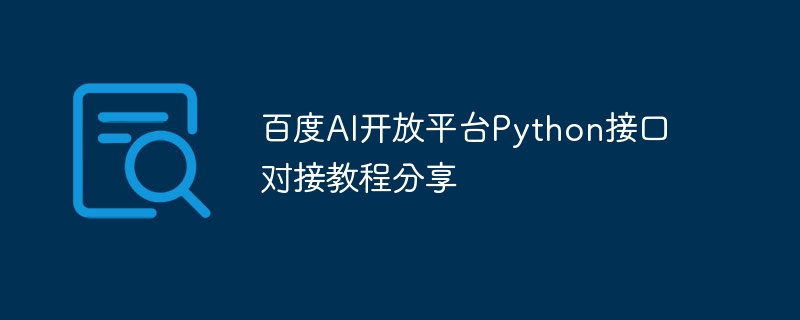

Baidu AI open platform Python interface docking tutorial sharing
With the rapid development of artificial intelligence, more and more developers are beginning to use artificial intelligence technology to solve problems and implement applications. Baidu AI open platform provides developers with rich artificial intelligence API interfaces to facilitate developers to quickly integrate artificial intelligence functions. This article will share how to use Python language to connect the interface of Baidu AI open platform and provide code examples.
Baidu AI open platform provides a rich artificial intelligence API interface, including speech recognition, image recognition, natural language processing and other functions. Before connecting these interfaces, we must first create an application on the Baidu AI open platform and obtain the corresponding API Key and Secret Key. In this article, we take Baidu's image recognition interface as an example to show how to use Python to connect to the interface of Baidu AI open platform.
First, we need to install the Python SDK of Baidu AI open platform. It can be installed through the pip command:
pip install baidu-aip
After the installation is completed, we can import the SDK of Baidu AI Open Platform and initialize it:
from aip import AipImageClassify # 替换为你的API Key和Secret Key APP_ID = 'your_app_id' API_KEY = 'your_api_key' SECRET_KEY = 'your_secret_key' client = AipImageClassify(APP_ID, API_KEY, SECRET_KEY)
Next, we can call the Baidu AI Open Platform’s SDK Image recognition interface performs image recognition. The following is a simple example to identify the subject of a local image:
def get_file_content(file):
with open(file, 'rb') as fp:
return fp.read()
# 读取本地图片
image = get_file_content('image.jpg')
# 调用百度AI开放平台的图像识别接口
result = client.advancedGeneral(image)
# 解析返回结果
if 'result' in result:
for item in result['result']:
print(item['keyword'])The above code first defines an auxiliary function get_file_content, which is used to read the content of the local image. Then, we call the image recognition interface of Baidu AI open platform through the client.advancedGeneral method and pass in the image content to be recognized. Finally, the analysis returns the results and outputs the identified topic keywords.
In addition to image recognition, Baidu AI open platform also provides many other useful API interfaces, such as text recognition, face recognition and natural language processing. Developers can choose the appropriate API interface according to their own needs and make interface calls according to the corresponding interface documents.
In practical applications, developers can also combine other Python libraries and frameworks to interface with the Baidu AI open platform to achieve more complex functions. For example, you can use web frameworks such as Django or Flask to build a web application for image recognition; you can use scientific computing libraries such as NumPy and Pandas to connect to natural language processing interfaces for text analysis.
In summary, Baidu AI open platform provides a wealth of artificial intelligence API interfaces. Developers can easily connect these interfaces through Python language to realize various intelligent functions. This article takes the image recognition interface as an example to introduce how to use Python and the API of Baidu AI open platform for integration, and gives corresponding code examples. I hope this article can help developers who connect to Baidu AI open platform interface and accelerate their artificial intelligence application development process.
The above is the detailed content of Baidu AI open platform Python interface docking tutorial sharing. For more information, please follow other related articles on the PHP Chinese website!